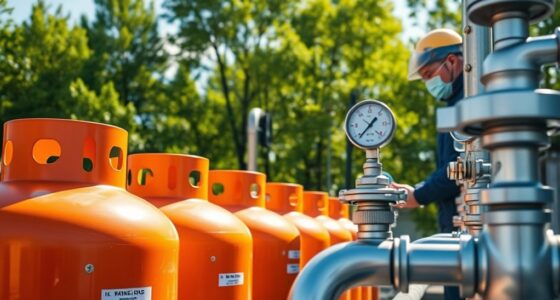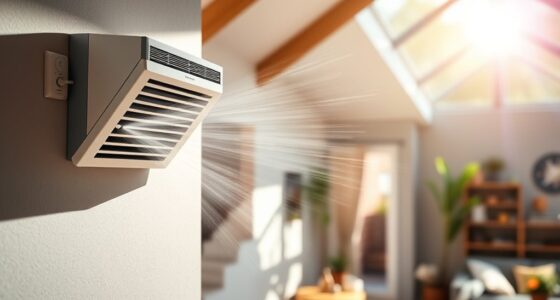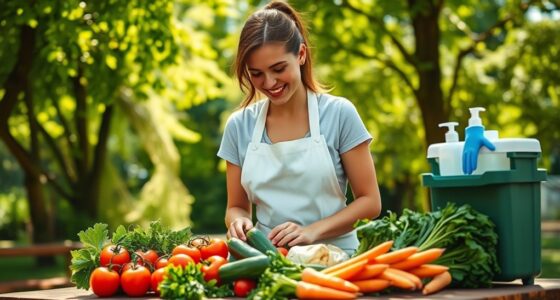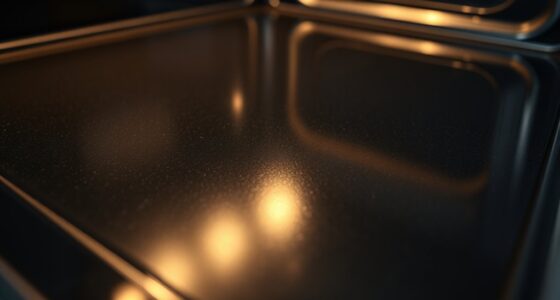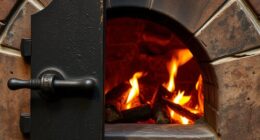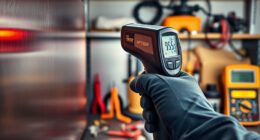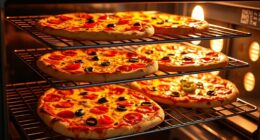To keep food safe outdoors, you must carefully calculate and monitor temperatures during storage, cooking, and holding. Use reliable thermometers to verify that hot foods stay above 140°F and cold foods stay below 40°F. Track how long items stay in the danger zone, plan proper insulation for transport, and prevent cross-contamination with designated areas. Master these calculations, and you’ll be better prepared—continue exploring to learn essential tips for outdoor food safety success.
Key Takeaways
- Calculate and monitor proper food temperatures during storage, cooking, and holding to prevent bacterial growth.
- Determine safe cold holding times, ensuring foods stay below 40°F, and use insulation or ice packs as needed.
- Verify reheating temperatures reach at least 165°F to ensure leftovers are safe for consumption.
- Use timers to track food exposure outside safe temperature zones, minimizing risk of contamination.
- Implement proper separation and packaging calculations to prevent cross-contamination during transportation and serving.
Understanding Safe Food Storage Temperatures
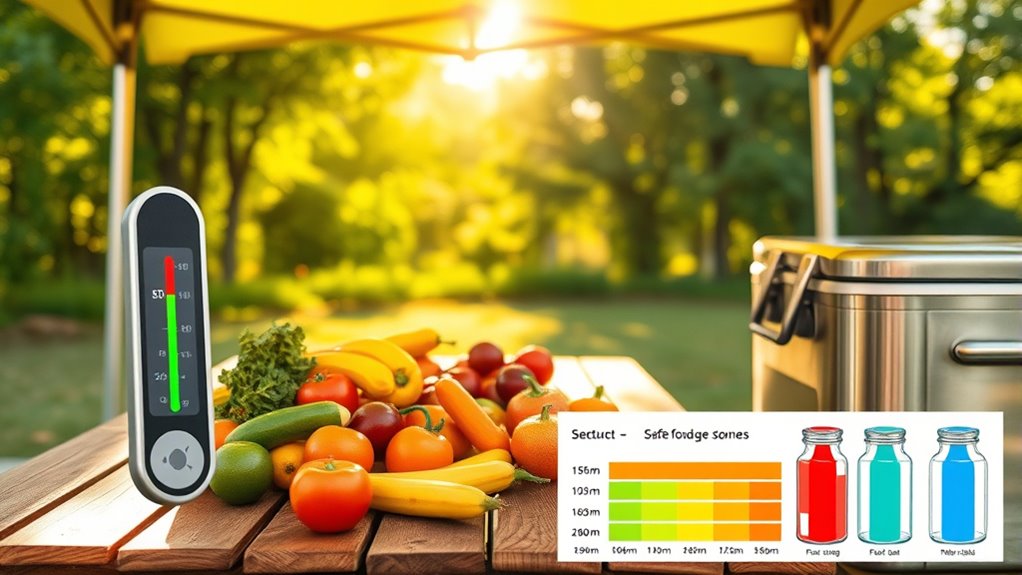
Understanding safe food storage temperatures is essential to prevent bacteria growth and keep your food safe. Using proper food storage containers ensures that perishable items stay within safe temperature ranges, reducing the risk of spoilage. Temperature-sensitive packaging plays a vital role when transporting food outdoors, helping to maintain the necessary cold or hot conditions. For cold storage, keep perishable foods at 40°F (4°C) or below, and for hot foods, maintain temperatures above 140°F (60°C). Always verify that your containers and packaging are suitable for temperature control, especially during longer outdoor events. Monitoring these temperatures helps prevent foodborne illnesses and ensures your outdoor meals remain fresh and safe to enjoy. Proper storage isn’t just about convenience; it’s about safeguarding health. Incorporating contrast ratio considerations can also improve the visibility of labels and temperature indicators on your packaging, making it easier to verify safe storage conditions.
Calculating Cold Holding Times for Perishable Items
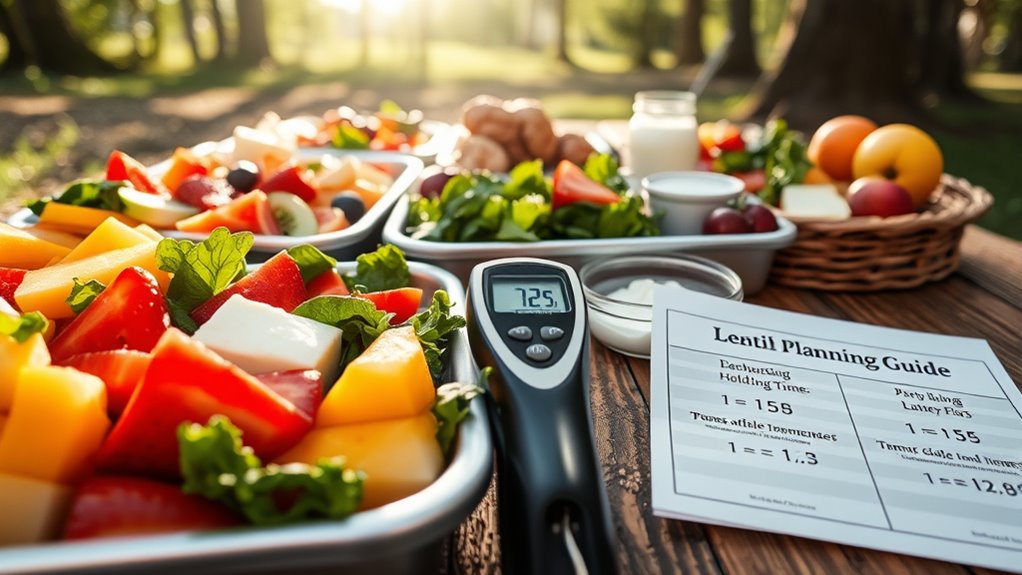
Knowing how long perishable foods can safely stay in the temperature danger zone is crucial when planning outdoor meals. To prevent foodborne illnesses, you need to calculate cold holding times accurately. Use a timer or thermometer to monitor how long items like salads or marinated meats remain below 40°F. Marinating techniques, especially when marinating at room temperature, can increase the risk if not properly timed. Keep perishable items chilled in coolers with ice or ice packs, and avoid leaving them out for more than two hours. Consider food presentation styles that keep cold items separate and on ice, reducing exposure. Proper food storage methods are essential to maintaining safety and quality during outdoor events. By managing cold holding times carefully, you ensure food safety while maintaining appealing presentation and quality.
Determining Proper Cooking Temperatures for Different Foods

Knowing the right internal temperatures guarantees your food is safe to eat. Follow food type guidelines to avoid undercooking or overcooking, especially when grilling outdoors. Keep a thermometer handy to monitor temperatures and ensure everything reaches safe levels. Regularly checking food safety standards helps prevent foodborne illnesses and ensures optimal cooking results.
Safe Internal Temperatures
Ensuring foods reach the right internal temperature is vital for safe outdoor cooking. Proper temperatures kill harmful bacteria and prevent foodborne illnesses. When planning your menu, consider food allergy awareness to avoid cross-contact and guarantee everyone’s safety. Use a reliable food thermometer to check internal temperatures accurately. Remember, different foods have specific safe temperature ranges:
- Poultry: 165°F (74°C)
- Ground meats: 160°F (71°C)
- Seafood: 145°F (63°C)
- Beef, pork, lamb (steaks, roasts): 145°F (63°C) with a 3-minute rest
- Leftovers: Reheat to 165°F (74°C)
Adhering to these temperatures helps prevent foodborne illnesses. It’s also vital to communicate temperature requirements during menu planning, especially for guests with allergies or sensitivities. Proper food storage and handling are equally important to maintain safety before cooking.
Food Type Guidelines
Different types of foods require specific internal temperatures to guarantee safety and quality. For example, meats like poultry should reach 165°F to eliminate harmful bacteria, while ground beef needs 160°F. Fish and seafood generally cook to 145°F, preserving texture and flavor. When preparing foods for presentation, ensure they’re cooked to these safe temperatures to avoid foodborne illnesses. It’s also essential to contemplate allergen labeling—some dishes may contain common allergens like nuts or shellfish, and proper cooking helps reduce cross-contact risks. Proper temperature guidelines help you serve food that’s not only safe but also appealing visually. Knowing the right internal temperatures for each food type ensures your outdoor meal remains safe, flavorful, and compliant with food safety standards.
Temperature Monitoring Tips
To accurately monitor temperatures while cooking outdoors, using a reliable food thermometer is essential. Proper temperature guarantees food safety and ideal flavor, especially when applying grilling techniques or spice pairing. Knowing the right internal temperatures prevents undercooking or overcooking, preserving quality and safety. When checking doneness, target specific temperatures for different foods, like poultry or beef. Keep in mind that resting meat after cooking allows juices to redistribute, maintaining flavor and tenderness. Always sanitize your thermometer between uses to avoid cross-contamination. For precision, insert the thermometer into the thickest part of the food, avoiding bones or fat. This practice guarantees your grilled dishes are safe and delicious every time.
Additionally, selecting a thermometer with vetted safety features ensures reliable readings and peace of mind.
Estimating Time to Chill Leftovers Safely

To keep leftovers safe, you need to cool them quickly within the recommended time frames. Knowing the right temperature guidelines helps you avoid bacterial growth. Let’s look at how long you should typically wait before chilling leftovers to guarantee safety. Using secure and reliable methods for payment processing can help ensure your food safety practices are protected from cyber threats.
Temperature Guidelines for Cooling
When cooling leftovers, it’s important to act quickly to prevent bacteria growth. Proper temperature guidelines guarantee your food stays safe and fresh. To do this effectively, consider how fast you need to bring hot foods down to 40°F (4°C). Use shallow containers to promote even cooling, which helps maintain good food presentation and supports your menu planning. Keep hot leftovers out of the temperature danger zone for as little time as possible.
- Divide large portions into smaller, shallow containers
- Use ice baths for rapid cooling when needed
- Avoid stacking hot items tightly in the fridge
- Label leftovers with date and time for tracking
- Monitor cooling temperatures regularly to stay within safe limits
Optimal Chill Time Frames
Estimating the ideal time to chill leftovers is crucial for maintaining food safety and quality. Proper chill time ensures leftovers stay safe to eat and preserve their food presentation, preventing spoilage. Typically, food should be cooled from hot to safe temperatures within two hours; in outdoor settings, this window might be shorter due to ambient heat. For menu variety, plan to divide large quantities into smaller portions to accelerate cooling. Using shallow containers helps distribute heat more evenly and reduces chill time. Keep leftovers out of the danger zone (40-140°F) to prevent bacteria growth. Monitoring the temperature regularly ensures safe storage. Additionally, understanding the cost of electric bikes can help in planning eco-friendly transportation options for outdoor events. By managing optimal chill time frames, you protect your guests’ health while offering a fresh, appealing menu with consistent quality.
Calculating Safe Reheating Temperatures and Times
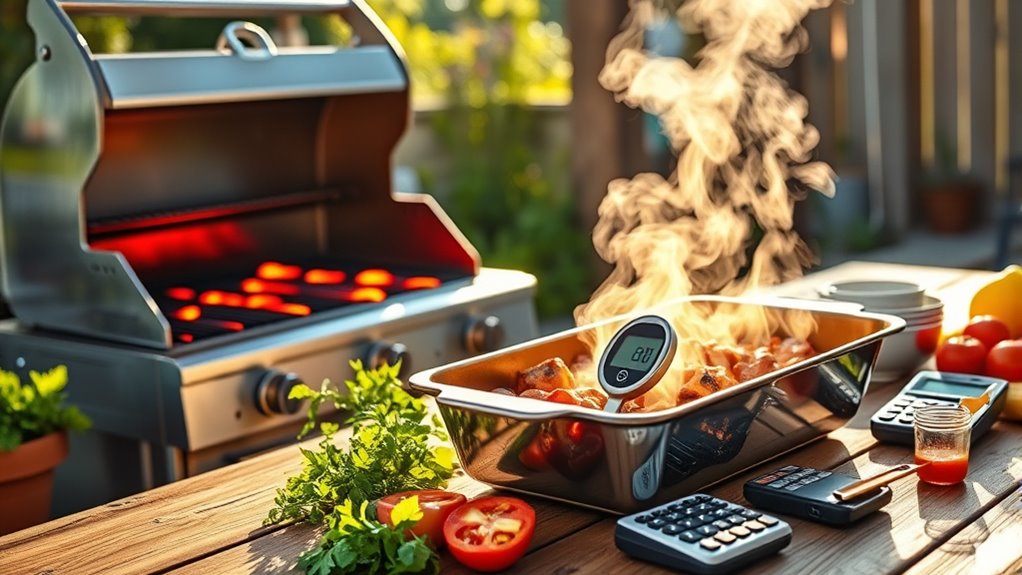
Calculating safe reheating temperatures and times is vital to prevent foodborne illnesses during outdoor cooking. Proper reheating ensures leftovers reach the right temperature to kill bacteria. Use appropriate reheating equipment, such as grills, portable stoves, or microwave ovens, to heat food evenly. Keep in mind that leftovers should be reheated to at least 165°F (74°C) to be safe. Timing is essential; don’t rush, and always verify the temperature before serving. Consider the thickness and type of food, as these affect reheating time. Monitor closely to avoid underheating or burning. Remember, reheating leftovers improperly can lead to health risks, so precision matters. Incorporating food safety practices ensures that reheating is both effective and safe. Proper planning guarantees safe, delicious outdoor meals for everyone.
Monitoring Food Temperatures With Thermometers

Using a thermometer to monitor food temperatures is the most reliable way to guarantee your outdoor meals are safe to eat. Digital probes provide quick, accurate readings, making it easier to confirm that foods reach proper internal temperatures. Always perform calibration checks before use to verify your thermometer is accurate; this involves testing it in ice water or boiling water. Regular calibration checks prevent false readings that could lead to undercooked or unsafe food. When using digital probes, insert the probe into the thickest part of the food, avoiding bone or fat. Record temperature readings at intervals to monitor ongoing cooking or holding temperatures. Proper temperature monitoring ensures your food remains within safe limits throughout the event. Reliable temperature monitoring helps maintain food safety and prevents foodborne illnesses during outdoor events.
Planning for Food Transportation and Insulation Needs
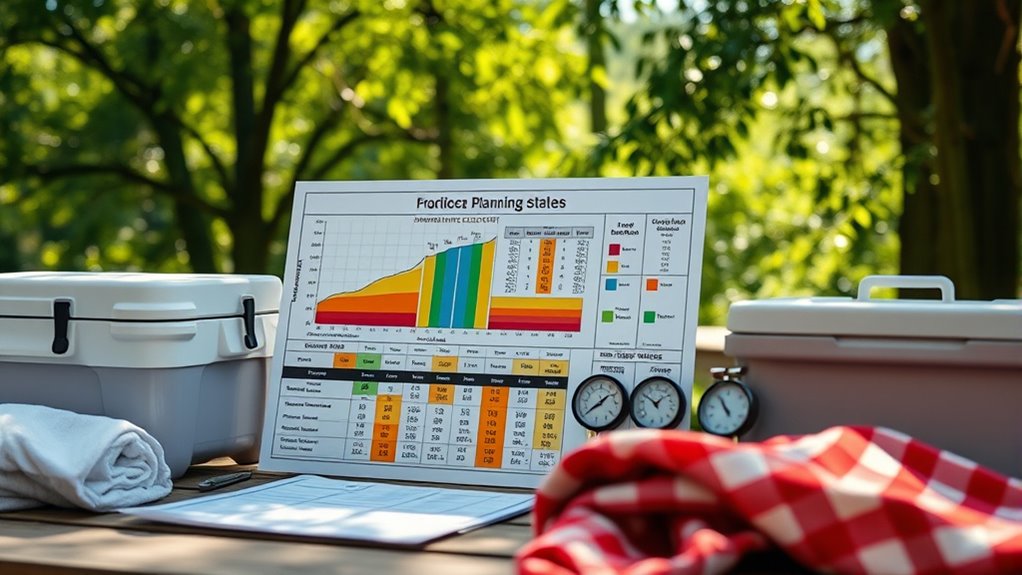
Properly planning for food transportation and insulation guarantees your meals stay safe and fresh until serving. Use appropriate food packaging to prevent leaks, contamination, and temperature loss. Select coolers or insulated containers that match your duration and ambient conditions to maintain proper temperatures. Consider emergency preparedness by packing extra insulation materials or ice packs for unexpected delays. Properly sealing and insulating your food prevents spoilage and cross-contamination risks. Additionally, choosing noise-reduction technology in your transport containers can help minimize disturbances during transit.
Managing Cross-Contamination Risks With Proper Separation
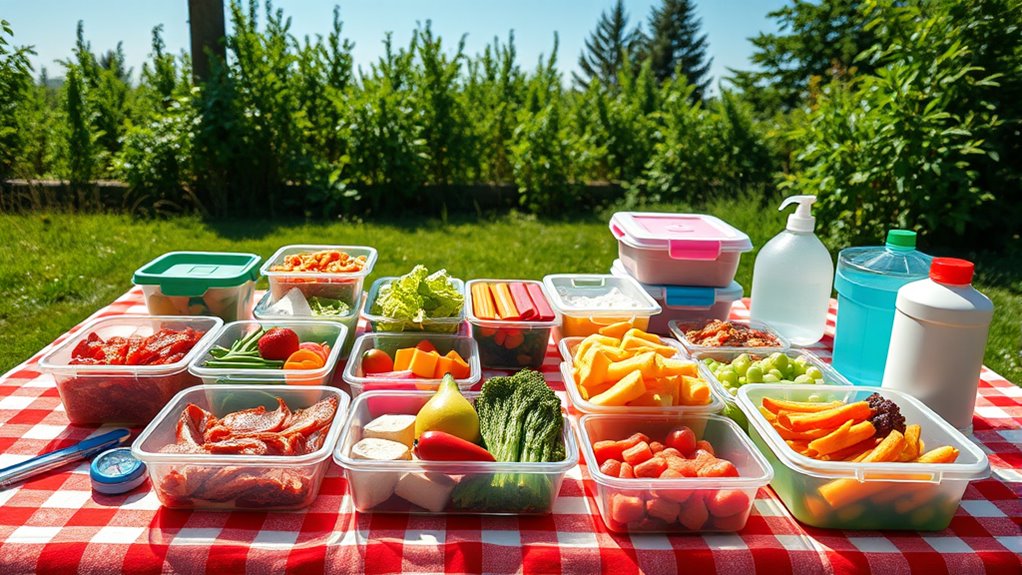
To prevent cross-contamination during outdoor food service, you need to carefully separate different types of foods. Using effective separation techniques is essential for contamination prevention. Designate specific areas or containers for raw meats, cooked foods, and ready-to-eat items, keeping them apart to avoid contact. Use color-coded cutting boards and utensils to reinforce separation and reduce the risk of transfer. Store raw products below cooked or ready-to-eat foods in coolers to prevent drips or leaks from contaminating other items. Maintain strict hand hygiene and change gloves when moving between raw and cooked foods. These separation techniques minimize cross-contact and help ensure food safety. Proper separation not only reduces health risks but also promotes confidence in your outdoor food service operation.
Estimating Duration for Safe Outdoor Food Serving
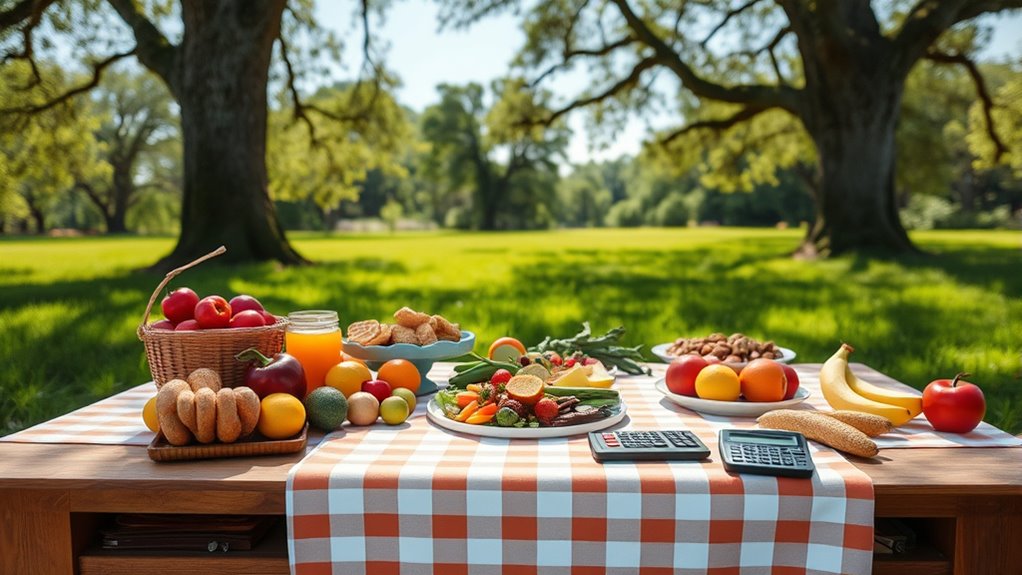
Determining how long food can safely stay outside is essential for preventing foodborne illnesses during outdoor dining. You need to contemplate factors like temperature, humidity, and the type of food when planning your menu. To keep everything safe, monitor ambient temperatures and limit the time perishable items are exposed. Properly estimating duration helps you avoid serving unsafe food.
Consider these key points:
- Keep hot foods above 140°F (60°C) and cold foods below 40°F (4°C)
- Use timers to track how long food has been out
- Prepare smaller batches to reduce exposure time
- Use insulated containers for maintaining temperatures
- Adjust menu planning based on expected outdoor conditions
Frequently Asked Questions
How Can I Prevent Food Spoilage During Unexpected Outdoor Delays?
To prevent food spoilage during unexpected outdoor delays, focus on proper food storage. Keep perishable items in a cooler with plenty of ice or ice packs to maintain safe temperatures. Avoid opening the cooler frequently to preserve cold air. If refrigeration isn’t available, consider using insulated containers or portable refrigeration devices. Staying vigilant about spoilage prevention helps guarantee your food remains safe and tasty until you’re ready to serve.
What Are the Best Insulation Methods for Outdoor Food Transport?
Think of your food as a delicate package, needing armor for its journey. For ideal transport insulation, use high-quality insulation materials like foam coolers, insulated bags, or reflective blankets. These materials act as a barrier, maintaining the right temperature and protecting against outdoor elements. Always make certain your transport insulation is tight-fitting and well-sealed, preventing heat exchange and keeping your food safe and fresh until it reaches its destination.
How Do Weather Conditions Affect Safe Food Handling Outdoors?
Weather conditions critically impact safe food handling outdoors. You need to watch weather patterns closely, as temperature fluctuations can cause bacteria to grow rapidly, risking food safety. Wind impact may disperse contaminants or blow debris onto food, so protect your supplies accordingly. Cold weather requires insulated containers to maintain proper temperatures, while hot conditions demand cooling methods. Always stay alert to changing weather to prevent foodborne illnesses and ensure safe, enjoyable outdoor meals.
What Are Quick Troubleshooting Steps for Temperature Fluctuations?
Imagine your cooler’s temperature rises unexpectedly during a picnic. First, check refrigeration maintenance to guarantee your cooler works properly. Then, verify thermometer accuracy to confirm the actual temperature. If fluctuations persist, immediately move perishable foods to another cooler or an ice-filled container. Regularly monitoring temps with a reliable thermometer helps catch issues early, preventing spoilage. Quick troubleshooting like this keeps your food safe and reduces the risk of foodborne illnesses outdoors.
How Can I Ensure Allergen Safety in Outdoor Food Service?
To guarantee allergen safety outdoors, always clearly label allergens on your menu and packaging. Prevent cross contact by thoroughly cleaning surfaces, utensils, and containers between uses. Use dedicated tools for allergen-free items and keep them separate from others. Train staff to recognize allergens and follow strict handling procedures. Regularly review your practices to ensure allergen labeling is accurate, and implement strict cross contact prevention measures for a safer outdoor food service experience.
Conclusion
By mastering these calculations, you’re not just planning a meal—you’re safeguarding lives and creating memories. Every temperature check and timing decision acts as a shield against unseen dangers, transforming your outdoor feast into a safe haven. Remember, in food safety, precision isn’t just a rule; it’s a promise you make to those you serve. Embrace these tools, and let your care shine brighter than any flame. Your vigilance guarantees everyone leaves with full hearts and healthy bodies.


